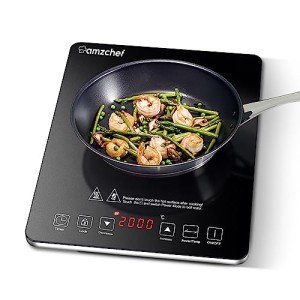A Proficient Rant Concerning Small Induction Hob
The Rise of Sleek Induction Hobs : A Modern Solution for Kitchen Efficiency
In the last few years, the cooking world has experienced a significant shift towards more efficient and user-friendly cooking methods. A significant contender in this advancement is the induction hob, often applauded for its sleek design and unequaled performance. This post explores the performance, benefits, and factors to consider of induction hobs, gearing up property owners and striving chefs with the knowledge they require to make an educated option.
What is an Induction Hob?
An induction hob is a type of cooktop that utilizes electro-magnetic energy to produce heat straight in cookware. This technology enables precise temperature control, quickly cooking times, and enhanced safety, making induction hobs an appealing function in modern kitchen areas.
How Induction Cooking Works
Unlike standard gas or electrical hobs, which depend on heating elements to warm the surface and consequently heat pots and pans, induction hobs produce a magnetic field that interacts with ferrous pots and pans (usually steel or cast iron). This interaction creates heat straight in the pot or pan, leading to quicker and more effective cooking times.
Here's an introduction of the induction cooking procedure:
- Magnetic Field Creation: When the hob is turned on, an electrical current travel through coils underneath the surface, developing a magnetic field.
- Heat Generation: The magnetic field induces an electric present in the pots and pans, causing it to heat up.
- Immediate Cooking: Since the heat is produced within the cookware, there is minimal heat loss, permitting rapid cooking and exact temperature modifications.
Secret Benefits of Induction Hobs
Induction hobs use a variety of advantages that attract both casual cooks and chef. Below are some of the main benefits of utilizing induction cooking:
Enhanced Efficiency: Induction hobs are considerably more energy-efficient than their gas and electrical equivalents. Roughly 90% of the energy produced is used for cooking, while gas stoves only utilize about 40% of the energy.
Quick Heating: The induction process warms pots and pans nearly instantly, significantly minimizing cooking times. For example, water boils much faster on an induction hob compared to conventional stovetops.
Temperature Control: Induction hobs provide accurate temperature level control, allowing cooks to achieve the required heat level for numerous cooking techniques, from searing to simmering.
Security Features: The hob surface area stays cool to the touch unless cookware is placed on it, greatly minimizing the threat of burns. Furthermore, many induction hobs include safety features such as automatic shut-off and recurring heat signs.
Sleek Aesthetic: The modern design of induction hobs includes a touch of elegance to kitchen spaces. Their flat surface areas are simpler to clean and blend perfectly with contemporary design.
Considerations Before Purchasing an Induction Hob
Regardless of their numerous advantages, there are some considerations to bear in mind when deciding to buy induction hobs:
Compatible Cookware: Only cookware made from magnetic products is suitable with induction hobs. This consists of cast iron, stainless-steel, and specific kinds of enameled pots and pans. Cookware made from glass, ceramic, or aluminum without a magnetic base will not work.
Greater Initial Cost: Generally, induction hobs can be more expensive in advance compared to gas or electric hobs. However, this cost can be balanced out with time by energy savings and increased cooking effectiveness.
Electrical power Dependency: Induction hobs require a trusted electrical power source to run, which could be a downside throughout power failures or in areas with irregular electrical supply.
Table: Comparison of Cooking Methods
Feature
Induction Hob
Gas Stove
Electric Hob
Energy Efficiency
High (90%)
Low (40%)
Moderate (70%)
Heating Time
Immediate
Moderate
Slower
Security
High
Moderate
Low
Surface Temperature
Cool
Hot
Hot
Cookware Compatibility
Magnetic-only
All types
Most types
Aesthetic Appeal
Sleek and modern
Standard
Basic
Frequently Asked Questions About Induction Hobs
1. Can I use non-magnetic pots and pans on an induction hob?No, only pots and pans
that is magnetic will work on an induction hob. Try to find pots and pans labeled as induction-compatible. 2. Do induction hobs consume more electricity?Induction hobs are developed for performance, consuming less electricity compared to
electrical hobs and gas ranges due to their quick heating capabilities. 3. Are induction hobs safe for children?Yes, induction hobs are considered much safer as the surface stays cool to touch. In addition, security features can be executed to
lock settings and restrict access. 4. How do I clean up an induction hob?Cleaning an induction hob is reasonably simple. Use a soft cloth or sponge with mild detergent. Avoid abrasive cleaners that can scratch the surface. 5. Can I set up an induction hob on my
own?While some induction hobs are developed for easy installation, it's recommended to hire a certified professional to guarantee proper setup and electrical connections.
Sleek induction hobs represent a
considerable improvement in cooking innovation, using exceptional effectiveness, security, and visual appeal. As more families seek to boost their cooking experiences,
the adoption of induction hobs continues to rise. With their fast cooking times, precise control, and modern style, induction hobs are not simply a trend but a valuable addition to contemporary kitchen areas, catering to the needs of both professional chefs and home cooks alike. Similar to any kitchen home appliance, it's crucial to weigh the pros and cons carefully to identify if an induction hob is the right choice for your cooking needs. 